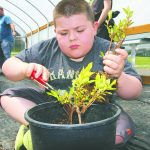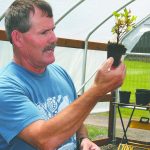Rick George has a dirty job.
The former teacher and coach, who started at Lebanon Middle School in 1979, now spends his partial retirement teaching kids in the garden – about 1,300 kids in 46 classes between five schools.
It’s a job George has been doing for more than 25 years. What started as a couple of bulbs planted with students during his lunch hour grew into a citywide effort and transformation of the community’s succeeding generations.
It all began back in 1980 when he participated in Lebanon Middle School’s Outdoor School, a week-long offsite camp that taught sixth-graders about plants, water, animals and soil. George took part in the program for the next 10 years, until it was cut from the budget in 1990.
While there, George noticed how some “stubborn” kids would go into the program refusing to participate in plant projects or campfire, but return home a different person.
“I saw those type of kids come to the Outdoor School and by the end of the week they were just thinking it was the greatest thing, and it changed them,” he said.
Between coaching and Outdoor School, George said, he realized kids were more invigorated when put in a different setting and given an opportunity to use their hands.
After Outdoor School ended, he took a different approach by raising lessons from the school’s own soil. Early on, administrators had resisted George’s out-of-the-box thinking, he said, but when he transferred to Seven Oak Middle School in 2002, he was given more freedom to educate students outside of the classroom.
“I have a classroom without walls,” he likes to say.
He was allotted a small piece of property situated outside his classroom, where he extended his teaching of science and math to sixth-graders.
For example, he could use a sunflower to teach circumference, diameter and radius.
“We teach them about angles, we teach them how to use a level,” he said. “We can teach them what square means, and how much cubic feet is in here, not just surface area.”
In 2006, George had to partially retire due to a family emergency, but returned to work in the greenhouse and teach as a substitute, he said. Then he and Ed Sansom, the principal at the time, agreed to try something different.
“As a teacher-coach all these years, I saw how kids were changed by being in something special,” George said.
He learned that coaching kids outside of class gave him an opportunity to encourage them to do better in their studies and behavior, so they took this idea and put it to the test.
In 2008, Master Gardener Sheryl Casteen responded to a request from the school district to help initiate the garden to cafeteria program, which became known as “Planting Seeds of Change.”
Along with another master gardener and some volunteers, the group tilled the soil, installed irrigation and built raised garden beds, Casteen said. The following school year, several students at Seven Oak were placed in the program.
“We took on a group of kids that were the toughest kids who didn’t succeed in the sixth grade – they didn’t pass the benchmarks; they had behavior issues,” George said.
These students were selected to be taught math and science in the garden during half the day. Casteen still remembers some of the ways George would teach them.
When the corn came in, she said, he would form two teams and have them chuck the corn into garbage cans placed about 10 or 15 feet away. Then he would ask how many students threw corn, how many corn cobs were thrown, and what percentage of cobs got into the can. To Casteen’s astonishment, the kids figured it out.
“They learned how to do math hands-on. This was a real lifelike test,” she said.
When she was their age, Casteen really struggled with math and concepts like cubic feet. She was “blown away” when she saw George take the students to a raised garden bed and explain that it was a cubic foot because it was 12 inches high, 12 inches wide, and 12 inches deep.
“They got it immediately,” she said.
Then he showed them that a seed packet would instruct a seed to be planted every 6 inches, and he asked the students how many seeds could be planted into a square foot.
“These were the types of tests he did that brought their scores up so fast,” Casteen said. “It was an eye-opener to me that these children learned so quickly because it’s right there in front of them.”
George, Sansom and Casteen agreed they since saw an improvement in the students’ testing and behaviors.
Some of these kids were malcontents and couldn’t care less about school, but they loved the garden and their test scores improved an average of 10 percent in 90 days, Casteen recalled. The program was such a success that parents began calling George to ask if their students could participate as well.
“It was really kind of an experiment to begin with,” Sansom said. “We were trying to get them to have some hands-on experience, trying to give them a little more than just how math works in the textbook.”
And not only were the kids improving mentally, but they were also enjoying the vegetables they grew, Casteen said.
“We couldn’t believe it. We couldn’t keep the vegetables. The minute they were ripe enough, the kids would eat them,” she said.
The vegetables that were leftover were delivered to the salad bar in the cafeteria, with a sign that read, “From our Garden.”
It was during this time that Nancy Kirks, then a coordinator for Samaritan Lebanon Community Hospital’s CHIP (Community Health Improvement Partnership) process, met with George.
“Rick was way ahead of his time,” she said in an email. “He was undoubtedly a ‘pied piper’ of sorts with these kids.”
She recognized that putting kids in a garden would not only teach them basic skills, but would also build their confidence and sense of teamwork and responsibility.
“I saw engaged, attentive and excited kids,” Kirks said. “They enthusiastically journaled, planted, checked greenhouse temperatures, weeded, harvested, sampled, logged plant growth and more.”
Together, Kirks and George implemented a partnership between the hospital and schools called “Bringing up Learning Behaviors,” using the acronym B.U.L.B. These students and their parents were invited to a special breakfast at the hospital with various community leaders.
What they wanted to do was bolster kids’ involvement in and enthusiasm for learning, Sansom said. While top students are named to the honor roll, B.U.L.B. would be a way to recognize students who actually showed an improvement in their grades and behavior.
Teachers began taking more notice of students who really deserved the award, and the kids, in turn, worked hard to earn it.
“The kids got to see it wasn’t just the garden; it was their behavior, it was their attitude, it was their work ethic,” Sansom said.
Today, B.U.L.B. continues through the Lebanon Police Department, and the fact they still embrace the program is an affirmation to the kids that the community is saying, “we’re all here working for you,” he said.
“The magnitude and influence this has brought to Lebanon community schools and to Lebanon itself has really expanded beyond anybody’s dream, but the person behind the dream was Rick George,” Sansom said.
George’s garden program has since expanded to all students at Cascades, Hamilton Creek, Pioneer and Riverview. As many as three classes in various grades meet every day in the garden to hear instructions, then break into groups to plant, prune or harvest.
George has been asked to speak about his work at the Oregon Garden Summit and the Oregon School Board Convention in Portland.
During summer break, he maintains the gardens on his own, but the kids return to find a bountiful harvest and plenty of work left for them to do.
“It’s the best time to garden in the Willamette Valley because it’s dry and warm, and you harvest everything,” he said.
The classes pick and clean lettuce, tomatoes, beans, apples, cherries, cucumbers, watermelon and beets, and then send them off to the cafeteria.
“You’re teaching them to be stewards of the garden,” George said. “You’re wanting them to sample the foods they have grown, and you want them to be excited about going into their school cafeteria.”
Students also take plants home during summer break, and return in the fall with stories of how well their plant did.
“The fact that the school garden is still operating is a testament to the power of partnerships,” Kirks said. “We can always accomplish ‘more together.’”
Most of the seeds they use are donated from Wilco and Walmart, while Van Essen Nursery donates soil and containers, George said, but he teaches the kids to harvest and reuse seeds as well.
Plant sales hosted by the schools help maintain the gardening program in the district, but donations and grants are also needed for the purchase of greenhouses and to hire a garden assistant, George said. His current assistant, Paul Johnstone, is provided through a grant, and he helps reduce the workload George has undertaken between the five schools.
“I’m pretty maxed out in terms of having the ability to get to all those places,” George said.
As an educator, coach, horticulture teacher and garden steward for the past 37 years, George will leave some pretty big shoes to fill when he fully retires. Although he has no plans to do so just yet, a looming question is how the work he started will continue when that time comes.
“I’ll have to stop some time, and I hope the district will continue it and can bring somebody else along to continue doing it,” George said.
A large part of the workload can be alleviated through continued community support, but volunteers tend to start out enthused and lose interest over a period of time, he noted. The other biggest factor is finding grant money to maintain the employ of an assistant.
“Without someone like [Rick], there wouldn’t be a garden, there wouldn’t be that kind of involvement, because he’s been there year in and year out, and he loves it,” Sansom said. “He’s just a unique human being.”
Casteen gave a nod to district Supt. Rob Hess, who, she said, stepped in with his full support of implementing the garden projects when maintenance workers complained about putting them in.
Hess recalled meeting George some 20 years ago, and watching a small plot of land blossom into five full-blown gardens.
“In order to have a garden at a school, you really need someone at the school that’s kind of like a champion of it, to make sure it’s kept up,” Hess said.
Hess remarked that many school gardens don’t work because no one’s available to keep them going in the summer. Planting begins in spring and is harvested in fall, so someone has to care for them in the meantime.
With all his work and volunteer time, including all he’s done in coaching, Sansom said he can think of no other person who has such drive and enthusiasm for Lebanon’s kids.
He said George, who was born and raised in Lebanon and has two sons and three grandchildren of his own, is entirely focused on young people.
“It’s almost like he’s never grown up in his heart.
“Rick is someone that I think has really maintained the integrity of what being a Lebanon Warrior or Lebanon resident means,” Sansom said. “I have nothing but the utmost respect and admiration for Rick in terms of what he has committed and led in that element of learning that is unique to Lebanon.”














